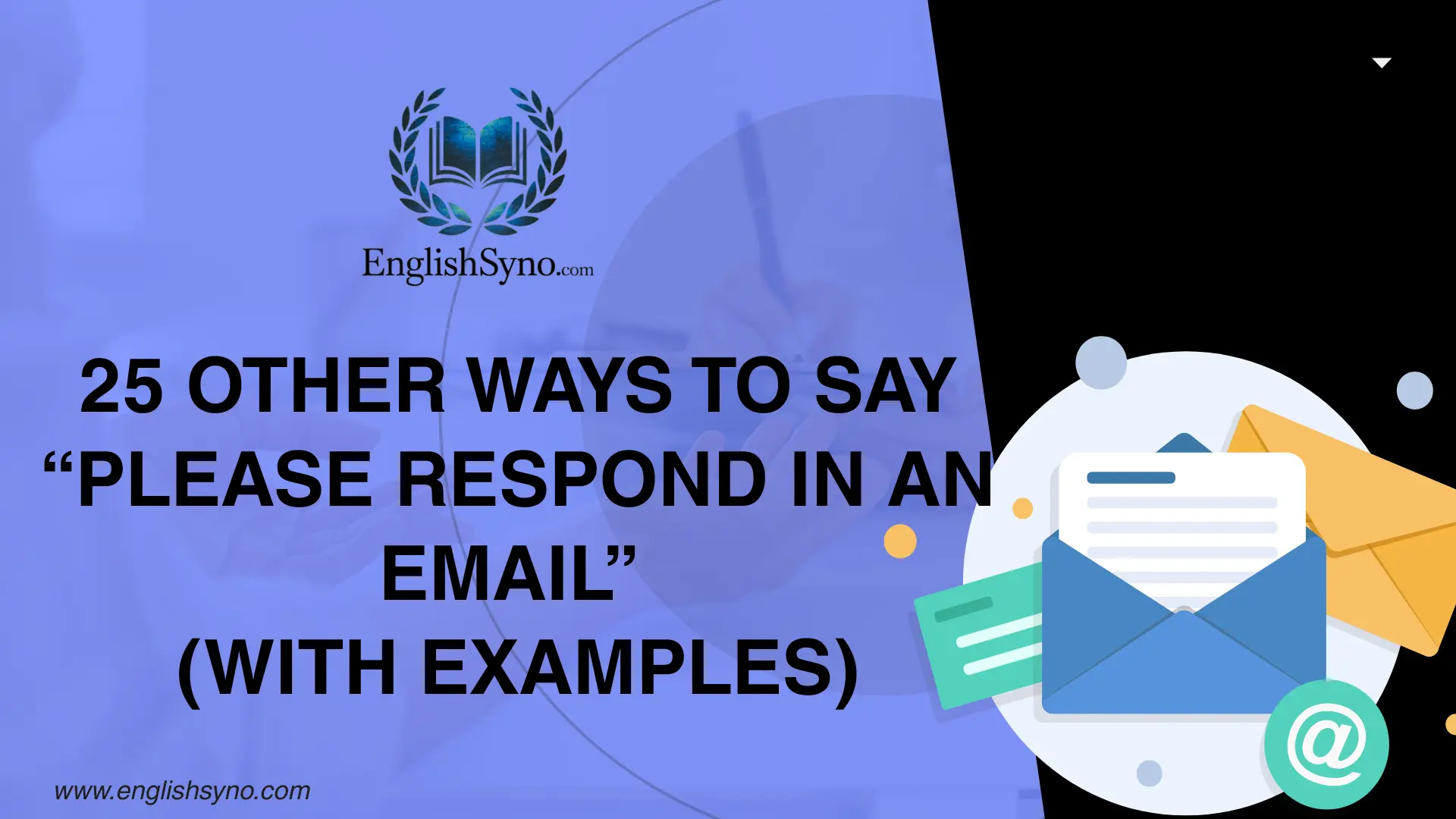When you send an email and ask someone to please respond in an email, your tone and message both play a vital role. In my writing experience, I’ve seen that a direct request can feel respectful and engaging when phrased with care. Whether you’re reaching out to colleagues, clients, or other contacts, a prompt, polite, and professional approach often earns a reply without sounding demanding. There are various ways to keep emails warm, effective, and natural, even when a quick answer is needed.
This article explores 25 alternatives designed to make your messages more effective. You can use templates or adjust your tone based on situations-both formal and informal make your request feel suitable and suited to the person you’re addressing. A gentle follow-up can be powerful, especially when getting a response seems tricky. Use these tips to choose the right alternative, helping you encourage healthy communication that remains respectful and natural throughout
What Does “Please Respond in an Email” Mean?
The phrase “please respond in an email” is a polite request asking someone to reply via email instead of another communication method. It’s often used in professional messages where documentation, clarity, or written confirmation is needed. The tone can range from formal to friendly, depending on how it’s written and who it’s addressed to.
When to Use “Please Respond in an Email”
Use this phrase when you need a record of the response, when details matter, or when it’s easier to manage communication via email rather than in meetings or chats. It’s also helpful for follow-ups, client correspondence, or situations where you need proof of communication for future reference.
Is It Professional or Polite to Say “Please Respond in an Email”?
Yes, it’s both professional and polite-when written thoughtfully. However, overusing it or making it sound commanding can make your message seem impersonal. A softer tone or phrasing like “I’d appreciate your response by email” or “Could you please reply when you get a chance?” can sound more considerate.
Pros or Cons
Pros:
- Clear and polite request for an email reply.
- Maintains professionalism and clarity.
- Keeps written documentation.
Cons:
- Can sound too formal or rigid if used repeatedly.
- May feel transactional in friendly or casual exchanges.
Kindly reply to this email
Meaning: A softer and courteous way to ask for a response.
Definition: This shows respect while maintaining professionalism.
Example Email:
Dear Sarah,
I hope you’re doing well. When you get a moment, could you kindly reply to this email with your thoughts on the proposal?
Warm regards,
Emily
Best Use: Ideal for professional settings where politeness matters.
Worst Use: Avoid in urgent messages needing immediate attention.
Tone: Polite and formal.
Looking forward to your response
Meaning: Expresses anticipation and respect for the recipient’s reply.
Definition: Keeps the tone hopeful without pressure.
Example Email:
Hi Mark,
I’ve attached the project outline below. Looking forward to your response soon.
Best,
Lisa
Best Use: Perfect for follow-ups or proposals.
Worst Use: Not suitable for urgent deadlines.
Tone: Friendly and professional.
I’d appreciate your reply
Meaning: Adds gratitude to your request.
Definition: Indicates politeness and value for the recipient’s time.
Example Email:
Dear John,
I’d appreciate your reply once you’ve reviewed the attached document.
Best regards,
Clara
Best Use: When dealing with clients or higher management.
Worst Use: Avoid in overly casual settings.
Tone: Respectful and professional.
Please let me know your thoughts
Meaning: Encourages collaboration and input.
Definition: Sounds conversational yet direct.
Example Email:
Hello Tim,
Please let me know your thoughts on the new pricing strategy by tomorrow.
Thanks,
Maya
Best Use: Great for team communication.
Worst Use: Avoid in situations where decisions are already final.
Tone: Friendly and cooperative.
I’d love to hear back from you
Meaning: Adds warmth and friendliness.
Definition: Makes your request more personal.
Example Email:
Hi Anna,
I’d love to hear back from you about the meeting schedule.
Take care,
Josh
Best Use: Suitable for personal or friendly business relationships.
Worst Use: Avoid in strict formal contexts.
Tone: Warm and inviting.
Can you please reply when convenient?
Meaning: Balances politeness with flexibility.
Definition: Acknowledges the recipient’s time.
Example Email:
Dear Michael,
When you have a moment, can you please reply when convenient?
Thanks in advance,
Olivia
Best Use: Best for non-urgent communication.
Worst Use: Not for time-sensitive tasks.
Tone: Polite and considerate.
Your response would be greatly valued
Meaning: Highlights appreciation.
Definition: Implies that their feedback is important.
Example Email:
Hi Jacob,
Your response would be greatly valued regarding our new campaign draft.
Regards,
Mia
Best Use: When asking for feedback.
Worst Use: Avoid if the matter is minor.
Tone: Professional and appreciative.
Awaiting your reply
Meaning: Indicates you’re expecting an answer soon.
Definition: Clear and concise but slightly formal.
Example Email:
Hello Sam,
Awaiting your reply on the updated schedule.
Thank you,
Karen
Best Use: Business correspondence.
Worst Use: Casual conversations.
Tone: Formal and direct.
Hope to hear from you soon
Meaning: Common and friendly closing.
Definition: Conveys eagerness without pressure.
Example Email:
Hi Ella,
I’ve shared the final version of the presentation. Hope to hear from you soon.
Best,
Brian
Best Use: General communication.
Worst Use: None-it’s universally acceptable.
Tone: Warm and neutral.
When you get a chance, please reply
Meaning: Respectful of the recipient’s schedule.
Definition: Adds patience to the message.
Example Email:
Dear Rachel,
When you get a chance, please reply with your availability.
Sincerely,
Kevin
Best Use: For busy colleagues or clients.
Worst Use: Not for urgent matters.
Tone: Relaxed and understanding.
Please confirm receipt
Meaning: Requests acknowledgment.
Definition: Ensures the email reached the recipient.
Example Email:
Hi Daniel,
Please confirm receipt of the attached files at your earliest convenience.
Thanks,
Lisa
Best Use: Ideal for document exchange.
Worst Use: Too formal for casual chats.
Tone: Professional and precise.
A quick reply would be appreciated
Meaning: Politely expresses urgency.
Definition: Requests prompt feedback without pressure.
Example Email:
Dear Emily,
A quick reply would be appreciated so we can finalize the schedule.
Regards,
Tom
Best Use: Tight deadlines.
Worst Use: Repeated follow-ups.
Tone: Courteous and urgent.
Please share your feedback
Meaning: Invites constructive input.
Definition: Encourages discussion.
Example Email:
Hello Alex,
Please share your feedback on the attached draft when possible.
Best,
Nia
Best Use: Team reviews and collaboration.
Worst Use: Finalized work.
Tone: Open and cooperative.
I await your kind response
Meaning: Very polite and formal.
Definition: Classic phrasing for official communication.
Example Email:
Dear Sir,
I await your kind response to my application.
Yours sincerely,
Rohan
Best Use: Official letters.
Worst Use: Everyday workplace messages.
Tone: Formal and respectful.
Please drop me a quick line
Meaning: Light and friendly.
Definition: Casual way to ask for a response.
Example Email:
Hey Ben,
Please drop me a quick line when you’re free.
Cheers,
Zoe
Best Use: Friendly or informal exchanges.
Worst Use: Professional contexts.
Tone: Casual and upbeat.
Kindly acknowledge
Meaning: Asks for acknowledgment of receipt.
Definition: Short and formal.
Example Email:
Dear Chloe,
Kindly acknowledge receipt of this document.
Regards,
Peter
Best Use: Official correspondence.
Worst Use: Informal notes.
Tone: Formal and concise.
Please keep me posted
Meaning: Requests ongoing updates.
Definition: Encourages consistent communication.
Example Email:
Hi Max,
Please keep me posted on any new developments.
Thanks,
Leo
Best Use: Projects or progress tracking.
Worst Use: One-time messages.
Tone: Professional yet friendly.
Could you please get back to me?
Meaning: Gently prompts for a reply.
Definition: Balanced between polite and assertive.
Example Email:
Hello Rita,
Could you please get back to me once you review the draft?
Best,
Adam
Best Use: Most professional scenarios.
Worst Use: Highly urgent cases.
Tone: Polite and natural.
Please advise
Meaning: Asks for guidance or input.
Definition: Short but respectful.
Example Email:
Hi James,
Please advise on how to proceed with the client request.
Regards,
Tina
Best Use: Requesting directions or advice.
Worst Use: Friendly emails.
Tone: Professional and succinct.
I’ll wait for your response
Meaning: Signals patience and expectation.
Definition: Keeps tone balanced.
Example Email:
Dear Clara,
I’ll wait for your response before confirming the next step.
Sincerely,
Dean
Best Use: Sequential tasks or approvals.
Worst Use: Informal conversations.
Tone: Neutral and courteous.
Looking forward to hearing from you soon
Meaning: Friendly and polite anticipation.
Definition: Very common in professional emails.
Example Email:
Hello Nina,
I appreciate your help and look forward to hearing from you soon.
Best,
Owen
Best Use: Closing statements.
Worst Use: None-it fits most contexts.
Tone: Warm and positive.
Eager to hear your feedback
Meaning: Shows enthusiasm.
Definition: Highlights interest in their thoughts.
Example Email:
Dear Ryan,
I’m eager to hear your feedback on the new product layout.
Thanks,
Amy
Best Use: Creative or collaborative work.
Worst Use: Routine emails.
Tone: Energetic and engaging.
Please get in touch
Meaning: Invites communication.
Definition: Simple and friendly.
Example Email:
Hi Jess,
Please get in touch once you’re ready to discuss next steps.
Best,
Aaron
Best Use: Networking or reconnecting.
Worst Use: Formal contracts.
Tone: Friendly and open.
Awaiting your valuable feedback
Meaning: Polite request for thoughtful input.
Definition: Appreciative and humble.
Example Email:
Dear Sophia,
Awaiting your valuable feedback on my presentation.
Regards,
Leo
Best Use: Submissions and creative reviews.
Worst Use: Quick yes/no replies.
Tone: Formal and gracious.
Please revert at your earliest convenience
Meaning: Formal version of “please reply soon.”
Definition: Common in corporate communication.
Example Email:
Dear Ms. Patel,
Please revert at your earliest convenience regarding the pending invoice.
Sincerely,
Arjun
Best Use: Business follow-ups.
Worst Use: Casual chats.
Tone: Formal and professional.
Final Thoughts
Crafting the right tone in your emails can make the difference between being heard and being ignored. “Please respond in an email” is a useful and professional phrase, but as this article shows, variety and warmth in wording can greatly improve how your message is received. Whether you’re addressing a client, colleague, or manager, choosing an alternative that suits the situation keeps your communication engaging, polite, and effective.
When you express your request with empathy—such as by saying “I’d appreciate your reply” or “Looking forward to your response” you encourage collaboration rather than obligation. The key is to sound respectful, not repetitive, and to adapt your message to the tone of your relationship and context.
In professional communication, every word shapes perception. A polite and thoughtful approach strengthens your credibility, shows emotional intelligence, and makes others more likely to respond promptly. Even simple touches like acknowledging someone’s time or using a friendly closing—add a layer of warmth that automated or impersonal messages often lack.
FAQs
What does “please respond in an email” mean?
It’s a polite request asking someone to reply via email instead of another method. It helps keep communication clear and documented.
Is it polite to say “please respond in an email”?
Yes, it’s polite if used thoughtfully. However, using softer phrasing like “kindly reply when you can” may sound more natural.
When should I say “please respond in an email”?
Use it when you need a written confirmation, response details, or a permanent communication record for reference.
What are alternatives to “please respond in an email”?
Try phrases like “looking forward to your reply,” “kindly respond,” or “please share your feedback” to sound warmer and more natural.
How do I make my email sound more professional?
Keep your tone polite, concise, and structured. Avoid slang and use greetings, respectful closings, and clear language throughout.
Should I follow up if I don’t get a response?
Yes, a friendly follow-up after 3–5 days is appropriate. Politely remind the recipient and restate your main request clearly.
Can I use this phrase in formal business communication?
Absolutely. It’s common in professional correspondence, especially when you need confirmation or feedback in writing.
What makes an email sound demanding?
Using abrupt language or skipping polite words like “please” and “thank you” can make your tone sound harsh or impatient.
How can I make my emails more engaging?
Personalize your message, add a warm greeting, and show appreciation for the reader’s time or input.
What’s the best closing line after asking for a response?
Try “looking forward to hearing from you” or “thanks in advance for your reply” for a polite and friendly finish.
How can I remind someone to reply without sounding rude?
Say “just checking in” or “following up on my last email” – gentle reminders that show respect for their schedule.
Is “please respond in an email” okay for casual messages?
It can sound too formal for casual emails. Instead, use “drop me a quick reply” or “let me know your thoughts.”
How do I handle no responses after multiple emails?
After two polite reminders, it’s best to give space or call if urgent. Persisting too often may appear pushy.
Why does tone matter in email communication?
Tone shapes how your message is perceived. A respectful, friendly tone builds trust and encourages quicker responses.
Can using polite alternatives improve relationships?
Yes, choosing kind and thoughtful phrases fosters mutual respect and makes professional communication smoother and more effective.



